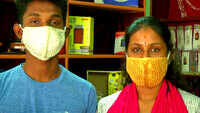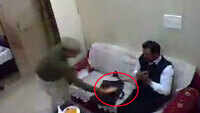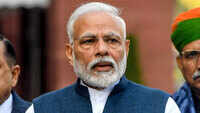
MUMBAI: When domestic flights were restarted in May, a motley staple of beverages from India’s domestic kitchens like haldi doodh, rasam, tulsi-mint shikanji, saffron sattu shake and amla aam panna — flying in on their reputation as immunity boosters — made their debut at food and beverage outlets of metro airports.
At airport lounges, pre-packed meal boxes have already replaced buffets, to prevent spread of coronavirus. Other flyers largely stick to home-cooked food. The attendant anxiety that comes with travelling amid the pandemic has altered the gastronomic scene at airports, but in the case of Indian airports, the sale of immunity boosters seems to have taken off.
Curcumin and Vitamin C drinks might not beat caffeinated beverages like tea and coffee, but in the past two months they have gained in popularity at various metros, says Gaurav Dewan, chief operating officer, Travel Food Services (TFS), which runs about 300 food outlets across various metro airports. There is a certain pattern to food preferences at metros though. “Haldi Doodh is the third largest selling beverage at Delhi airport and so is Tulsi-Mint Shikanji at Kolkata airport. Predictably, Rasam is popular at Chennai airport. Immunity boosters have been doing so well, we’ve been thinking of bottling and marketing it,’’ he said.
Another meal that has picked up sales across India’s airports during the pandemic is curd rice. “It’s a light meal, its healthy and fermented. Among our south Indian fare, curd rice used to account for only 2-3% of sales in pre-covid times, now it accounts for over 15-20% and is sold throughout the day,’’ he says. Among food items that have dropped in terms of preference are non-vegetarian meals. “We don’t know whether it’s related to Covid or the changed customer profile,’’ he said.
The pandemic has forced a mix of new menu options and technology onto the airport food scene.
The manner of ordering food has changed as well. It’s common to now find employees walking around with iPads to help people order food. Scan a QR code, read the menu, choose the item, pay online and collect the order from the outlet. Akshara Pratap, a student who boarded a Delhi-Mumbai flight two weeks ago said: “Hardly any passengers were ordering or having meals. But quite a few were having beverages, probably tea or coffee. We were curious about contactless order and so I bought a cappuccino. But most eateries inside the terminals are still closed.”
At lounges, the new normal translates to pre-packed meals in spill-proof boxes. Pradip Somani, a frequent flyer on the Mumbai-Delhi route said, “In June, I travelled for the first time after lockdown was imposed. I stepped into the lounge at Mumbai airport to kill time and not to eat, as buffets are known to aid the spread of Covid. I was surprised to find a boxed meal of paneer, rice and roti instead. Other passengers too were rather okay with the new normal reality of boxed meals in lounges”.
At airport lounges, pre-packed meal boxes have already replaced buffets, to prevent spread of coronavirus. Other flyers largely stick to home-cooked food. The attendant anxiety that comes with travelling amid the pandemic has altered the gastronomic scene at airports, but in the case of Indian airports, the sale of immunity boosters seems to have taken off.
Curcumin and Vitamin C drinks might not beat caffeinated beverages like tea and coffee, but in the past two months they have gained in popularity at various metros, says Gaurav Dewan, chief operating officer, Travel Food Services (TFS), which runs about 300 food outlets across various metro airports. There is a certain pattern to food preferences at metros though. “Haldi Doodh is the third largest selling beverage at Delhi airport and so is Tulsi-Mint Shikanji at Kolkata airport. Predictably, Rasam is popular at Chennai airport. Immunity boosters have been doing so well, we’ve been thinking of bottling and marketing it,’’ he said.
Another meal that has picked up sales across India’s airports during the pandemic is curd rice. “It’s a light meal, its healthy and fermented. Among our south Indian fare, curd rice used to account for only 2-3% of sales in pre-covid times, now it accounts for over 15-20% and is sold throughout the day,’’ he says. Among food items that have dropped in terms of preference are non-vegetarian meals. “We don’t know whether it’s related to Covid or the changed customer profile,’’ he said.
The pandemic has forced a mix of new menu options and technology onto the airport food scene.
The manner of ordering food has changed as well. It’s common to now find employees walking around with iPads to help people order food. Scan a QR code, read the menu, choose the item, pay online and collect the order from the outlet. Akshara Pratap, a student who boarded a Delhi-Mumbai flight two weeks ago said: “Hardly any passengers were ordering or having meals. But quite a few were having beverages, probably tea or coffee. We were curious about contactless order and so I bought a cappuccino. But most eateries inside the terminals are still closed.”
At lounges, the new normal translates to pre-packed meals in spill-proof boxes. Pradip Somani, a frequent flyer on the Mumbai-Delhi route said, “In June, I travelled for the first time after lockdown was imposed. I stepped into the lounge at Mumbai airport to kill time and not to eat, as buffets are known to aid the spread of Covid. I was surprised to find a boxed meal of paneer, rice and roti instead. Other passengers too were rather okay with the new normal reality of boxed meals in lounges”.
Download
The Times of India News App for Latest India News

Coronavirus outbreak
Trending Topics
LATEST VIDEOS
India
 Chhattisgarh: Naxals beat up villagers for seeking development
Chhattisgarh: Naxals beat up villagers for seeking development  This face mask made of gold will set you back by Rs 2.75 lakh
This face mask made of gold will set you back by Rs 2.75 lakh  Senior MP cop sent to police HQ after controversial video clip emerges
Senior MP cop sent to police HQ after controversial video clip emerges  3 terrorist killed in Shopian encounter on July 18 Brigadier Ajay Katoch
3 terrorist killed in Shopian encounter on July 18 Brigadier Ajay Katoch  Assam floods: State govt providing ration to people living in relief camps
Assam floods: State govt providing ration to people living in relief camps  PM Modi inquiries about Covid-19 positive servicemen
PM Modi inquiries about Covid-19 positive servicemen
More from TOI
Navbharat Times
Featured Today in Travel
Quick Links
Coronavirus in MumbaiCoronavirus in KolkataCoronavirus in HyderabadCoronavirus in DelhiCoronavirus in BangaloreCoronavirus symptomsCoronavirus in IndiaWhat is CoronavirusCoronavirus NewsSolar EclipseNPRWhat is NRCCAB BillCAB and NRCRTI BillPodcast newsLok SabhaShiv SenaYSRCPCongressBJP newsUIDAIIndian ArmyISRO newsSupreme Court
Get the app



